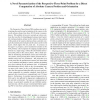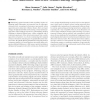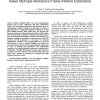ICASSP
2011
IEEE
13 years 9 months ago
2011
IEEE
This paper addresses the problem of rate distortion analysis in the context of multi-view image coding, where images are predicted via disparity compensation based on depth map. W...
CVPR
2011
IEEE
13 years 9 months ago
2011
IEEE
The Perspective-Three-Point (P3P) problem aims at determining the position and orientation of the camera in the world reference frame from three 2D-3D point correspondences. This ...
TCSV
2010
14 years 25 days ago
2010
In dual frame motion compensation (DFMC), one short-term reference frame and one long-term reference frame (LTR) are utilized for motion compensation. The performance of DFMC is he...
JOCN
2010
14 years 27 days ago
2010
Maintaining spatial orientation while travelling requires integrating spatial information encountered from an egocentric viewpoint with accumulated information represented within ...
ICMCS
2009
IEEE
14 years 3 months ago
2009
IEEE
In the H.264/AVC coding standard, motion estimation (ME) is allowed to use multiple reference frames to make full use of reducing temporal redundancy in a video sequence. Although...
ICIP
2010
IEEE
14 years 4 months ago
2010
IEEE
The major gain in video coding applications compared to single image coding is the use of temporal prediction, which exploits the correlation between adjacent frames. However, in ...
TCSV
2008
14 years 6 months ago
2008
This paper proposes a simple yet effective mechanism to select proper reference frames for H.264 motion estimation. Unlike traditional video codecs, H.264 permits more than one ref...
JMM2
2008
14 years 6 months ago
2008
The design of virtual reality user interfaces (VRUI) is still an open field of research and development. One category of VRUI is the 3D floating menus that can be manipulated by us...
DATE
2010
IEEE
14 years 11 months ago
2010
IEEE
—Motion Estimation (ME) is the most computationally intensive part of video compression and video enhancement systems. One bit transform (1BT) based ME algorithms have low comput...
ICMCS
2005
IEEE
14 years 11 months ago
2005
IEEE
Recent video coding standards such as H.264 offer the flexibility to select reference frames during motion estimation for predicted frames. In this paper, by tracking loss compen...



